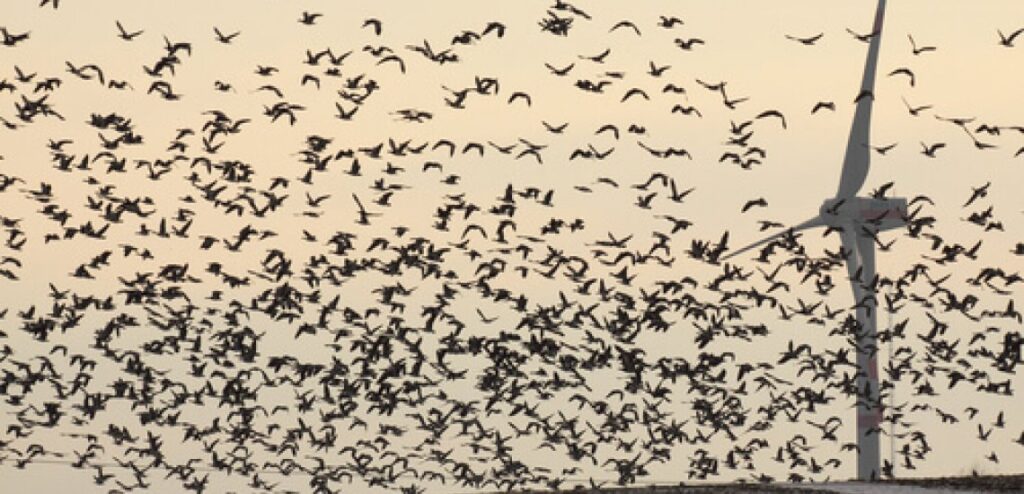Great news: BirdLife South Africa halts plans for dangerous wind farm

BirdLife supports renewable energy – but not when it comes at the expense of wildlife. In recent years, plans to build a wind farm near an important site for migratory birds have caused much concern among conservationists. Now, opposing action has put it on ice.
By Cressida Stevens
In a warming world, wind power is a hugely promising and much-needed solution to combat our over-reliance on fossil fuels. We know that wind farms are one of the most environmentally-friendly energy sources. Besides using a renewable resource, wind turbines release minimal amounts of carbon dioxide and actually take up very little land space since their structures occupy the air, rather than the land. However, for animals that need that air space, they can pose big problems.
The most obvious threat to birds and bats is direct and fatal collisions with blades. Besides this, turbines can affect their flight by disrupting air currents or displacing those birds that actively avoid turbines, such as geese, from their usual foraging areas. The Groot Winterhoekberg in the Eastern Cape is an ecologically important site, among other things it has a high density of raptors. The site is adjacent to a wilderness area as well as a portion of the Cape Floristic Region World Heritage site and under consideration for protected area expansion.
BirdLife South Africa was therefore devastated when, in April 2018, plans to build the Inyanda Roodeplaat Wind Farm in the Eastern Cape’s Groot Winterhoekberg had been given the environmental go-ahead. The greater of two goods is clear in this case: this would be a major blow to Africa’s biodiversity. Yet thankfully, this was not the end of the story.
The authorisation was granted in the midst of criticism and controversy. First, when the impact assessment for birds came out opposed to the wind farm, the applicant called for a reassessment by a different expert, who, whilst agreeing that it would have a detrimental impact on birds, argued that this could be mitigated. As well as this, there were allegations of misconduct to bias the assessment, and even rumours of burning eagle nests and bird shootings to mask the site’s importance to key species.
Research has shown that the bird group most likely to fatally collide with wind turbines are birds of prey. Of particular concern would be the risk posed to the Verreaux’s Eagle Aquila verreauxii (regionally Vulnerable), Martial Eagle Polemaetus bellicosus (Vulnerable, regionally Endangered), and the Black Harrier Circus maurus (Endangered) which resides only in southern Africa. The proposed site for the turbines is on top of a mountain, in the direct line of flightpaths used by the birds.
For this reason, BirdLife South Africa, along with four other stakeholders, strongly appealed against the decision to allow the development of the Inyanda Roodeplaat Wind Farm.
Although BirdLife South Africa is in favour of wind energy, it is against the development of wind farms in or close to protected areas or sites where they may jeopardise populations of threatened species. To help developers avoid these areas, BirdLife International coordinates the Energy Task Force. Established by the Convention on Migratory Species, this aims to identify cost-effective locations where renewable energy structures can be built without harming birds.
In fact, BirdLife partners across the world are creating detailed bird sensitivity maps which highlight areas where renewable infrastructure will conflict with wildlife. These tools are now available in many countries, including Scotland, Greece, Slovenia and South Africa. BirdLife South Africa has also written guidance to help insure that impacts on species at risk are adequately assessed and mitigated. With these resources available, it was very disappointing that the Inyanda Roodeplaat Wind Farm has been given such consideration.
Despite the bleak outlook, good news came in late April of this year when Ms L. Zulu, the Acting Minister of the Department of Environmental Affairs in South Africa, upheld BirdLife’s appeal – a major victory for the environment. The matter has been remitted to the Department for further consultation and reconsideration.
Although the application remains in contention, BirdLife South Africa is now very optimistic that logic will prevail and the proposal will be declined.
The story acts as a reminder of the need for perseverance in complex issues of conservation – in a seemingly lost cause, there is always a chance of a turnaround. BirdLife hopes that in the future, renewable energy will continue to expand, with developers increasingly referring to the Energy Task Force to select sites that will not endanger wildlife and mean that there need be no compromise between protecting birds and combating climate change.
“Renewable energy is an important part of our climate change mitigation strategy”, concludes BirdLife South Africa, “but it should not be at the expense of resilience to climate change. Resilience depends on healthy, intact environments. Through our work, we help achieve that balance”.


